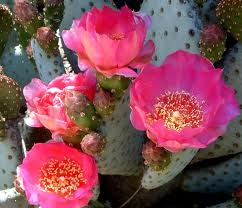All cactuses here are on sale. We do domestic and international shipping for low prices
Opuntia basilaris Beavertail Cactus is a smaller Prickly Pear Cactus. Rare and exotic cactus plants High quality cactus plants for sale Buy cactus plant Best Prices
Description of Opuntia basilaris
Family: Cactaseae
Scientific Name: Opuntia basilaris Engelm. & Bigelow
Common Name(s): Beavertail Cactus - Beavertail Prickly Pear (Referring to the pads that remember the tail of a beaver )
Origin: Southwest USA (Arizona, California, Nevada) from 200 to 3000 feet elevation (60 to 900 m), northwestern Mexico (northern Baja California and northern Sonora)
Conservation Status: Listed in CITES Appendix II
Etymology: The genus name "Opuntia" refers to a Greek name used by Pliny for a diverse plant which grew in the region of the town of Opus in Greece.
(The genus name implies: “plant of the town of Opus”).
The species name "basilaris" derives from the Latin "basilis" which means “basal” and the suffix "-aris". ( The specific name implies: "from the base, basal").
Description: This is a smaller prickly pear, branching upwards to 30cm (60 cm) high in clumps up to 90cm (1.2 m) in diameter.
The Beaver-tail Cactus will often start blooming when it has only two pads. Beware that the glochids (these little barbed bristles organized in clusters) can penetrate the skin.
In the wild, its principal range is limited to the Mojave-Colorado desert.
Succulent to 2 feet tall (60 cm), 4 feet spread (1.2 m); green or slightly purplish segments 3.2 to 5.6 inches long (8-14 cm), 1.6 to 4 inches wide (4-10 cm), glabrous or slightly pubescent; slightly pleated during the dry season; areoles, many with white or brown wool and brownish glochids; occasional spine in the upper areoles, or spineless.
Stalk: Oval to roundish blue-gray-green, with a blush of purple pigmentation (due to the presence of betacyanins pigments) that vary in function of temperature, glabrous or slightly covered with a velvety pubescence, smooth to wrinkled in dry conditions. New pads stretching from the lower areas of the plant.
Glochids: While lacking spines the plant is well protected with copious and effective glochids that fill each areole and easily penetrate the skin.
Spines: Usually spineless, if a few spines are present they are confined to the upper rim of the pad.
Central (S):
Radial (S):
Areolas: Numerous with white or brown wool (3 mm of diameter), filled with brownish-reddish clustered bristles 3mm long (glochids).
Flowers: The beaver tail cactus has 2.6-3 inches wide (6-7 cm), fuchsia colored flowers in March-April. The spineless fruit is dry when ripe. The seeds are 0.24 to 0.4 inch in diameter (6-10 mm)
Fruits: Spineless, globular to obovate 4cm long. Tan grey and dry at maturity, areoles 24–76 usually puberulent. The fruits can be cooked, as well as the pads.
Seeds: Large, rounded, smooth, cream colored, 0.5 to 1cm in diameter.
Habitat: Grows in very arid plains and valleys (rainfall mostly in winter from 200 to 500 mm/year) in sandy or rocky soils with a basic pH (Ranges 6 to 8), from sea level to 1300m
Recommended Temperature Zone: USDA: 7-10
Sun Exposure: Full sun
Water Needs: little or no water once established, in its natural distribution area, it receives mostly winter rains.
Cultivation: Best to grow in very fast draining mineral soils this plant is very rot prone, needs little water once established, avoid acid soils rich in humus or clayey. Tolerates sand. Keep dry in winter.
Frost Tolerance: Hardy to -5°: Sun Exposure: They need maximum light exposure in full sun. Avoid shadow. Handle with precautions to avoid the prickly glochids, besides the blue pruina that cover the cladodes may be allergenic for same people.
Soil pH requirements:
Min Temperature: Frost Tolerance: Hardy to 0°F (-18°C)
Propagation Methods: Cuttings, or seeds
Seed Collecting:
Other: Plant from different places of origin are somewhat variable in coloration, growth habit, pubescence, and flower color.
Translate This Page
Opuntia basilaris Beavertail Cactus - Beavertail Prickly Pear rare Cactus Plants for sale
MyCactusPlants.com San Diego, CA provides Rare cactus plants, indoor cactus plants, desert cactus plants. If you interested where to buy a cactus, buy cactus here. Our cacti have a high quality. We inspect every cactus before realization.
To better choosing what cactus to buy, we supply cacti for sale with quality cactus plants pictures.
Opuntia basilaris Beavertial Cactus

Opuntia basilaris Rooted pads for Sale
$ 5.00 USD New price $4.00.
$ 5.00 USD New price $4.00. Out of stock
Opuntia basilaris seedlings for sale
Seedlings have a strong root system. They more stable to rot than rooted segments..
We have two years old Opuntia basilaris seedlings for sale. Price $5.00